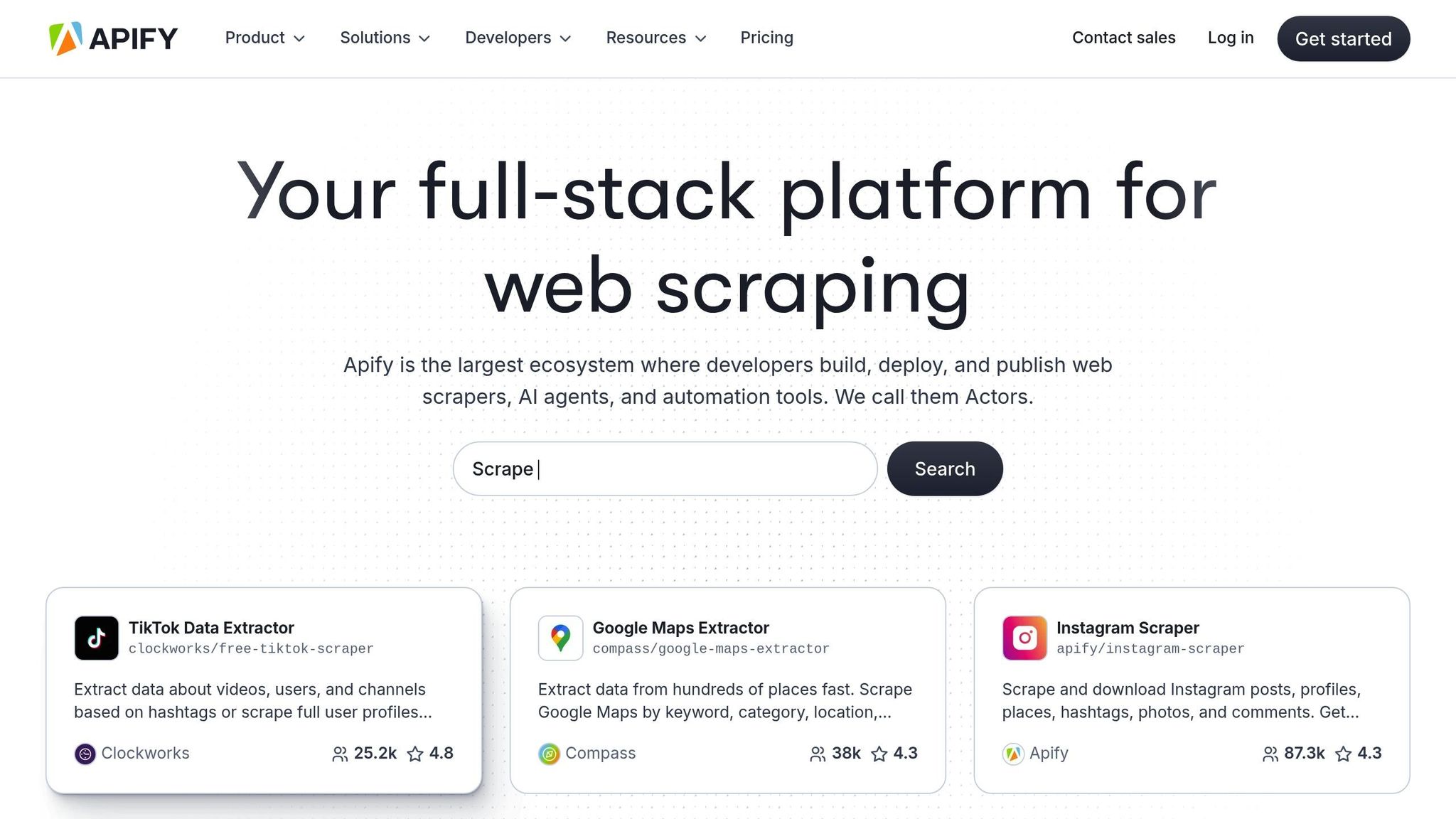
- Harsh Maur
- April 20, 2025
- 6 Mins read
- RetailTechnology
How Retailers Use Product Scraper to Prevent Stockouts & Overstocks?
Retailers lose billions annually due to poor inventory management. Stockouts drive customers away, while excess stock eats into profits. The solution? Product Scraper.
What is Product Scraper?
It's a tool that collects real-time data from online sources, like prices, stock levels, and trends. This data helps retailers:
- Avoid stockouts by automating reorders when inventory runs low.
- Reduce overstock by tracking demand patterns and redistributing surplus items.
- Stay competitive by monitoring market trends and competitor pricing.
Why it matters:
- U.S. retailers lose $252.9 billion annually from stock issues.
- Stockouts lead 91% of customers to shop elsewhere.
- Overstock costs North America $123.4 billion yearly.
With Product Scraper, you can achieve 98% inventory accuracy and cut costs by 99.7%, ensuring smarter, data-driven stocking decisions.
Effects of Poor Stock Management
Poor inventory practices cost U.S. retailers billions annually through missed sales and inefficiencies. Globally, the retail sector loses an estimated $1.1 trillion due to inventory mismanagement, with North American retailers alone shouldering $252.9 billion in losses from stockouts and overstocks. These numbers highlight why tools like Product Scraper are critical for precise inventory control.
When Products Are Out of Stock
Stockouts have a major impact on revenue. For example, empty shelves cost the U.S. retail food industry $15–20 billion annually in lost sales, and 91% of customers leave after encountering a single stockout.
Stockouts also lead to increased costs, with 43% of retailers reporting higher expenses for rush shipping and storage due to fluctuating inventory.
When Too Much Stock Is Held
Holding too much inventory comes with its own set of challenges, including:
- 3.2% average annual revenue loss
- $123.4 billion in overstock-related losses in North America annually
- Higher warehouse and storage costs
- Increased markdowns, reducing profit margins
- Strained cash flow
These issues often intensify during busy seasons when storage is limited, and discounts are needed to clear out excess inventory before new stock arrives.
Finding the Right Stock Level
Product Scraper helps retailers strike the perfect balance by offering real-time data analysis and predictive tools. This approach addresses what IHL President Greg Buzek identifies as a key issue:
To maintain proper stock levels, retailers can use the following strategies:
- Real-time monitoring: Keep a constant eye on inventory across all sales channels.
- Demand pattern analysis: Leverage historical data to predict future needs.
- Automated reordering: Set smart triggers to replenish stock automatically.
- Supply chain optimization: Build strong relationships with dependable suppliers.
Next, we’ll dive into the core Product Scraper features that make these strategies possible.
Product Scraper Features

Retailers are increasingly relying on Product Scraper to tackle inventory challenges and maintain control over their stock.
Types of Data Collected
Product Scraper gathers detailed information on prices and availability from leading e-commerce platforms, marketplace listings, and supplier catalogs. It tracks SKU-specific details like stock levels, price changes, and promotional deals across various channels. This real-time data feeds directly into reorder systems, helping retailers avoid both shortages and excess inventory.
Connecting with Store Systems
The platform integrates effortlessly with popular ERP and POS systems through API connections, ensuring automated synchronization of data. It processes incoming information and updates inventory records instantly, keeping stock levels accurate across all sales platforms. Integration with warehouse management systems also enables automatic reorders based on current demand trends.
Data Rules and Standards
To maintain data accuracy, Product Scraper uses built-in validation rules and customizable thresholds. It standardizes product details from different sources, ensuring proper matching and categorization while flagging any irregularities for further review. These protocols help retailers avoid errors and keep their inventory management precise.
sbb-itb-65bdb53
4 Steps to Use Product Scraper
With Product Scraper's main features in place, follow these four steps to streamline your inventory workflow. This process helps you gather accurate inventory data and turn it into actionable information.
Step 1: Define Stock Goals
Start by setting clear goals for inventory monitoring, such as ensuring service levels, highlighting scarcity, or managing limited-edition items. Decide how often you'll review stock: daily for fast-moving products, and weekly for seasonal or high-end items.
Key areas to focus on:
- Goals: Service levels, scarcity messaging, limited editions
- Frequency: Daily for fast sellers, weekly for seasonal or luxury items
- Logistics: Stock locations, restocking policies, transfers, and handling unsold inventory
Use past inventory data to spot seasonal trends and adjust for potential issues like restocking delays, data entry errors, or mismatches between systems.
Step 2: Select Data Sources
Identify the websites or sales channels that represent your inventory. Balance the need for frequent updates with the cost of data collection by adjusting how often you scrape each source.
Consider these guidelines:
- Use daily or even more frequent checks for fast-moving items; weekly updates work for slower sellers.
- Map out all the online stores or warehouses you need to monitor.
- Understand industry restocking patterns to interpret sudden changes in stock levels.
- Account for potential errors caused by website updates, time delays, or system mismatches.
Step 3: Configure Data Collection
Set up Product Scraper to pull inventory data from your selected sources.
Key setup details include:
- Observation frequency: Daily, intraday, or weekly
- Locations: List of warehouses or fulfillment centers
- Error handling: Rules for dealing with website changes or missing data
This setup ensures you’re not caught off guard by site updates or delays in restocking.
Step 4: Build Alert Systems
Turn your inventory data into actionable alerts:
- Reorder alerts: Triggered when stock falls below a set level
- Transfer prompts: To redistribute overstocked items
- Dead-stock flags: For products that remain unsold or are returned
Customize these alerts based on sales trends, lead times, seasonal demand, and acceptable error margins. Then, analyze these alerts alongside sales data to fine-tune your reorder points and keep your inventory levels optimized.
Product Scraper Results
After setting up alert systems, retailers can track outcomes effectively using Product Scraper.
Key Advantages
Retailers achieve noticeable improvements in inventory management:
- 98% stock accuracy, with weekly snapshots reducing costs by 99.7%
- Real-time sales tracking, such as monitoring 21 units sold within 24 hours
- Automation replaces manual data entry and inventory checks, thanks to pre-built scraping tools
Despite these advantages, there are some recurring issues retailers encounter.
Common Challenges
-
Complex Data Structures
Many websites have intricate page layouts and APIs. To streamline your process, focus on scraping only the fields you need. Use stable CSS or XPath selectors to maintain accuracy. -
Frequent Site Changes
Retail platforms often update their layouts and underlying code. Stay proactive by monitoring these changes and adjusting your scraping methods to match new structures. -
Rate Limits and Anti-Scraping Defenses
Sites may enforce rate limits or block IPs to prevent scraping. To avoid disruptions, adhere to rate limits, randomize request intervals, and use proxies to distribute traffic. -
Data Quality Issues
Scraped data can sometimes contain errors due to caching delays or inconsistent formats. Use validation techniques like cross-referencing multiple sources, checking values against expected ranges, and conducting regular audits to ensure reliability.
When using Product Scraper for inventory management, it’s essential to follow website policies, collect only publicly available data, respect scraping intervals, and comply with data privacy regulations.
Conclusion
Key Takeaways
Product Scraper helps US retailers optimize stock levels by providing real-time monitoring and enabling smarter, data-driven decisions.
Here’s what it brings to the table:
- Improved Inventory Tracking: Retailers get detailed insights into product categories, descriptions, pricing, and discounts.
- Minimizing Waste: By keeping tabs on unsold inventory it helps reduce excess stock.
These benefits set the stage for retailers to fine-tune their data processes and analytics for even better outcomes.
FAQs
Find answers to commonly asked questions about our Data as a Service solutions, ensuring clarity and understanding of our offerings.
We offer versatile delivery options including FTP, SFTP, AWS S3, Google Cloud Storage, email, Dropbox, and Google Drive. We accommodate data formats such as CSV, JSON, JSONLines, and XML, and are open to custom delivery or format discussions to align with your project needs.
We are equipped to extract a diverse range of data from any website, while strictly adhering to legal and ethical guidelines, including compliance with Terms and Conditions, privacy, and copyright laws. Our expert teams assess legal implications and ensure best practices in web scraping for each project.
Upon receiving your project request, our solution architects promptly engage in a discovery call to comprehend your specific needs, discussing the scope, scale, data transformation, and integrations required. A tailored solution is proposed post a thorough understanding, ensuring optimal results.
Yes, You can use AI to scrape websites. Webscraping HQ’s AI website technology can handle large amounts of data extraction and collection needs. Our AI scraping API allows user to scrape up to 50000 pages one by one.
We offer inclusive support addressing coverage issues, missed deliveries, and minor site modifications, with additional support available for significant changes necessitating comprehensive spider restructuring.
Absolutely, we offer service testing with sample data from previously scraped sources. For new sources, sample data is shared post-purchase, after the commencement of development.
We provide end-to-end solutions for web content extraction, delivering structured and accurate data efficiently. For those preferring a hands-on approach, we offer user-friendly tools for self-service data extraction.
Yes, Web scraping is detectable. One of the best ways to identify web scrapers is by examining their IP address and tracking how it's behaving.
Data extraction is crucial for leveraging the wealth of information on the web, enabling businesses to gain insights, monitor market trends, assess brand health, and maintain a competitive edge. It is invaluable in diverse applications including research, news monitoring, and contract tracking.
In retail and e-commerce, data extraction is instrumental for competitor price monitoring, allowing for automated, accurate, and efficient tracking of product prices across various platforms, aiding in strategic planning and decision-making.